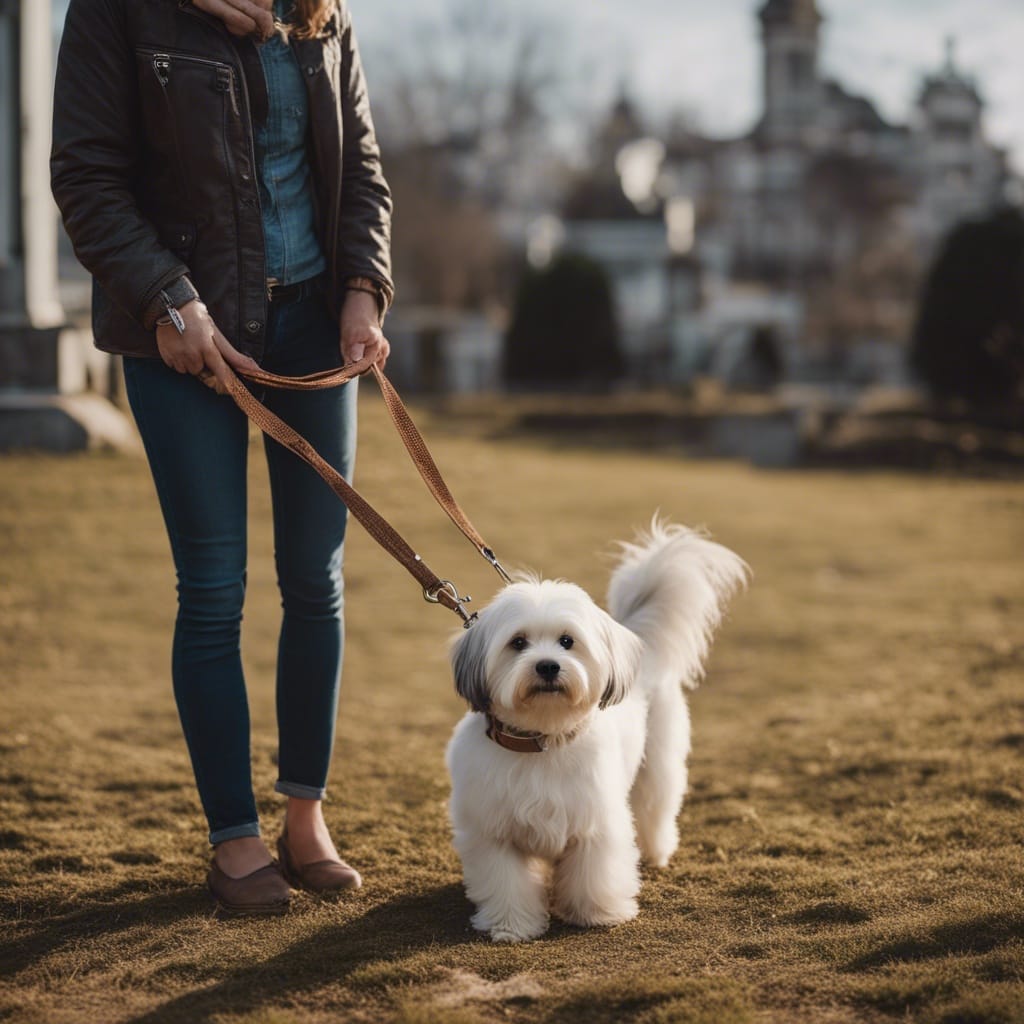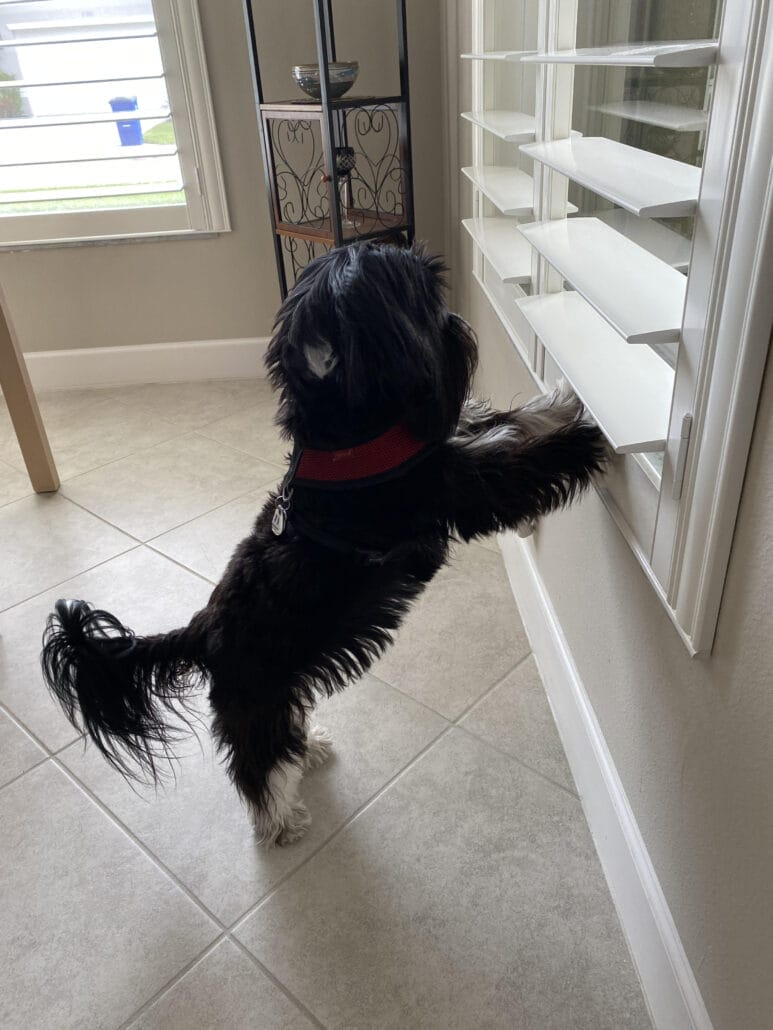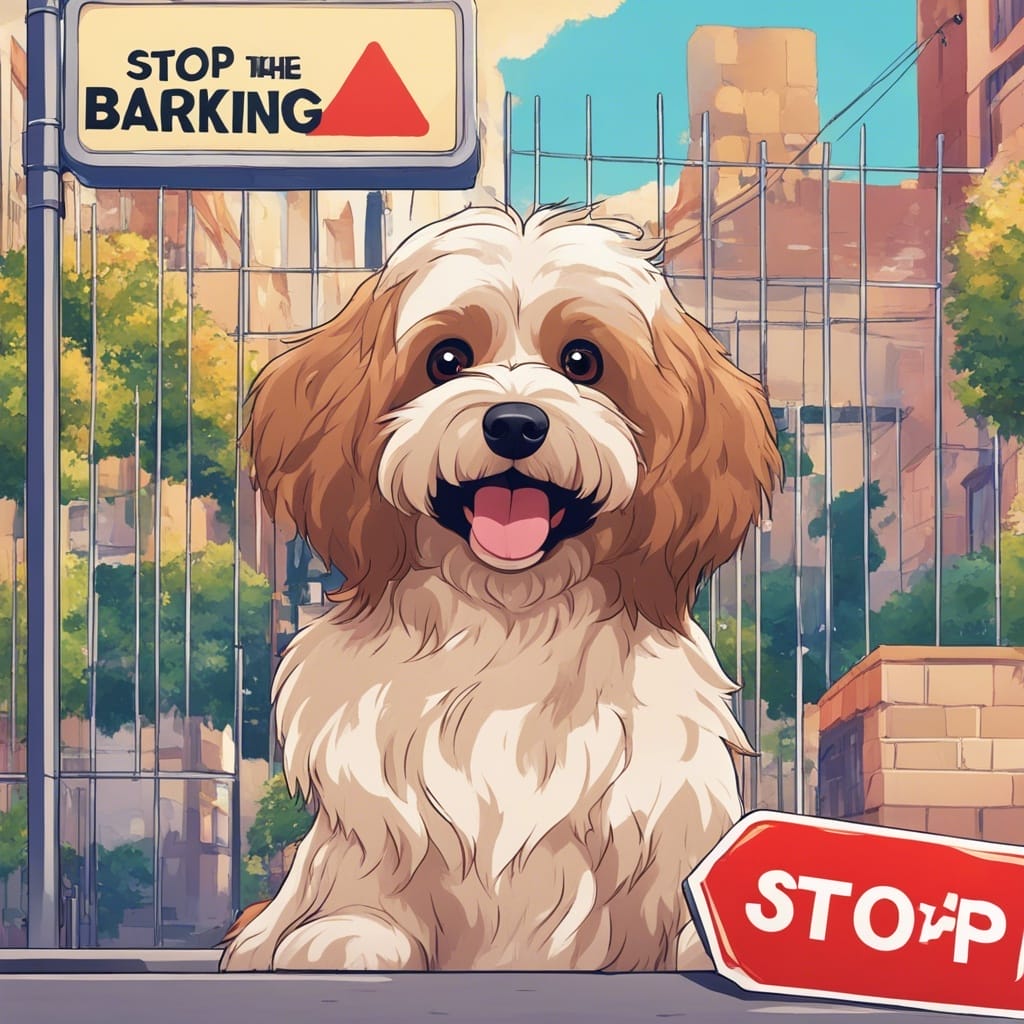
Solving common behavior problems in Havanese dogs involves consistent training and positive reinforcement. This breed responds well to rewards, socialization, and setting boundaries.
| Behavior Problem | Description |
|---|---|
| Excessive Barking | Havanese dogs can be vocal, and excessive barking can become disruptive |
| Separation Anxiety | Strong bonding tendencies can lead to distress when left alone |
| Chewing | Havanese dogs may exhibit destructive chewing behavior |
| Jumping | Jumping on people or furniture can be a common behavior problem |
| Not Listening to Commands | Havanese dogs may struggle with obedience and following instructions |
| Fear and Anxiety | Havanese dogs can exhibit fear and anxiety-related behaviors |
| Resource Guarding | Havanese dogs may become possessive or protective over their food, toys, or other resources |
| Aggression | Some Havanese dogs may display aggression toward humans or other animals |
| Pulling on the Leash | Havanese dogs may pull excessively when being walked on a leash |
| House Soiling | Accidents inside the house can be a behavior problem in Havanese dogs |
Havanese dogs are known for their friendly and affectionate nature, but like any dog, they can develop behavior problems if not properly trained. Luckily, with some patience and consistency, these issues can be resolved. One common problem is excessive barking.
Excessive barking and separation anxiety can disrupt the harmony in your home, but fear not! We have effective strategies to tackle these issues and more. Let’s dive in.

Silencing the Barking Brigade:
- Identify triggers and redirect their attention.
- Engage their brilliant minds with puzzle toys and regular exercise.
- Watch as their need to bark diminishes.
Conquering Separation Anxiety:
- Havanese dogs form strong bonds, but leaving them alone can trigger distress.
- Gradually desensitize them and teach them to be comfortable with solitude.
- Witness separation anxiety fade away, fostering independence.
Tackling Chewers, Jumpers, and Disobedience:
- Chewing, jumping, and ignoring commands can be frustrating.
- Consistent training using positive reinforcement techniques is the key.
- Reward good behavior with treats and praise, redirecting their actions.
Patience, Consistency, and Positive Reinforcement:
- Managing behavior problems takes time and dedication.
- Train, socialize, and mentally stimulate your Havanese.
- Watch them transform into well-behaved and joyful companions.
Don’t let behavior problems overshadow the joy of having a Havanese as your furry friend. With the right approach, you’ll build a harmonious bond that will last a lifetime.
Understanding Havanese Behavior Problems
Solve common behavior problems in Havanese dogs with a better understanding of their behavior issues. Discover effective strategies for addressing these problems and fostering a harmonious relationship with your furry companion.
As a dog owner, it’s important to understand that behavior problems can arise in any breed, including Havanese dogs. While Havanese dogs are known for their friendly and affectionate nature, they can still exhibit certain behavioral issues that need to be addressed. By understanding these common behavior problems and taking necessary measures, you can ensure that your Havanese is a well-behaved and obedient companion.
Common Behavior Problems In Havanese Dogs
Havanese dogs are generally social and love being around their human family members. However, there are a few behavior problems that are commonly observed in this breed:
- Separation anxiety: Many Havanese dogs can experience separation anxiety when left alone for long periods of time. This can lead to destructive behaviors like chewing furniture or excessive barking.
- Excessive barking: While barking is a natural way for dogs to communicate, excessive barking can become a problem. Havanese dogs, in particular, may bark excessively when they are bored, anxious, or seeking attention.
- Aggression: Although Havanese dogs are generally friendly, they can sometimes display aggressive behaviors towards other dogs or unfamiliar people. This aggression can be a result of fear, territorial behavior, or lack of proper socialization.
- House-soiling: Some Havanese dogs may struggle with house training, leading to accidents inside the house. This can be frustrating for both the owner and the dog and requires consistent training and positive reinforcement.
- Jumping on people: Havanese dogs are known for their exuberant and lively personality, which can sometimes result in jumping on people. While this behavior may seem harmless, it can become problematic, especially if the dog jumps on children or elderly individuals.
Importance Of Addressing Behavior Issues For A Well-behaved Companion
Addressing behavior issues in a Havanese dog is crucial for turning them into a well-behaved and obedient companion. By tackling these problems early on, you can prevent them from worsening and establish a strong bond with your furry friend.
A well-behaved Havanese not only brings joy to your life but also ensures a harmonious living environment. Additionally, addressing behavior issues helps to keep your dog safe and prevents them from engaging in behaviors that may put them at risk of injury or harm.
Training and addressing behavior problems in Havanese dogs require patience, consistency, and positive reinforcement. It is essential to understand the underlying causes of these behaviors and to tailor your training approach accordingly.
Remember, a well-behaved Havanese is a happy Havanese, and by investing time and effort into addressing their behavior issues, you will have a wonderful companion that brings you endless love and companionship.
Socialization And Training: Key Factors For Behavior Management
Socialization and training are crucial for managing behavior problems in Havanese dogs. By focusing on these key factors, pet owners can address and solve common issues to create a well-behaved and happy companion.
Early Socialization And Its Impact On Behavior
Early socialization plays a crucial role in shaping the behavior of Havanese dogs. During the critical developmental period, which typically lasts from birth to around 16 weeks of age, proper socialization can help prevent behavior problems in the future. Exposing your Havanese puppy to various people, animals, sounds, and environments helps them develop confidence and adaptability.

By regularly introducing your Havanese to new experiences, you are allowing them to become familiar with different stimuli, reducing the likelihood of fear or aggression towards unfamiliar people or situations. Socialization also helps build positive associations, making it easier for your dog to approach new experiences with curiosity and open-mindedness.
Positive Reinforcement Training Methods For Havanese Dogs
When it comes to training your Havanese, positive reinforcement methods are highly effective for behavior management. These training techniques focus on rewarding desired behaviors, rather than punishing unwanted ones. By incorporating treats, praise, and play as rewards, you create a positive association with the desired behavior, encouraging your dog to repeat it.
Havanese dogs are known to be intelligent and eager to please, making them well-suited for positive reinforcement training. By consistently rewarding your dog for good behavior, you can build a strong bond and foster a cooperative attitude, resulting in more reliable obedience and better overall behavior.
In addition to rewards, it is important to establish clear boundaries and consistent rules for your Havanese. Dogs thrive on routine and structure, so providing them with consistent guidance and expectations will help them understand what is expected of them.
Ultimately, early socialization and positive reinforcement training go hand in hand when it comes to managing behavior problems in Havanese dogs. By investing time and effort into socializing your puppy and using positive training methods, you set them up for success, ensuring they grow up to be well-adjusted and well-behaved companions.
Solving Separation Anxiety In Havanese Dogs

If you own a Havanese dog, you may have noticed their lovable nature and desire for constant companionship. While this breed’s attachment to their owners can be endearing, it can also lead to separation anxiety when left alone. Recognizing the signs of separation anxiety and implementing effective strategies can help alleviate this problem and create a more harmonious environment for both you and your furry friend.
Recognizing Separation Anxiety Signs
Before you can start addressing separation anxiety in your Havanese dog, it’s crucial to understand the common signs of this condition. While each dog may exhibit slightly different behaviors, some of the most typical signs include:
- Pacing or excessive restlessness
- Barking or howling excessively when left alone
- Attempting to escape or destroy objects in the home
- Excessive drooling or panting
- Toileting or urinating indoors, even when potty-trained
By recognizing these signs, you can intervene more effectively and implement strategies to minimize your Havanese dog’s anxiety.
Creating A Safe And Comforting Environment
One of the keys to tackling separation anxiety is creating a safe and comforting environment for your Havanese dog. This includes:
- Providing a designated space that is cozy and filled with familiar items, such as their bed, toys, and a piece of clothing with your scent.
- Using pheromone diffusers or calming sprays to create a serene atmosphere.
- Playing soft and soothing music or leaving a television on at a low volume to mimic the sounds of human presence.
These simple adjustments can help your Havanese dog feel more secure and relaxed when home alone.
Gradual Desensitization Techniques
Gradual desensitization is another effective technique for reducing separation anxiety in Havanese dogs. This process involves gradually increasing the duration of time you are away from your dog, starting with short intervals and gradually extending them over time. Here’s how you can implement this technique:
- Start by leaving your dog alone for just a few minutes while providing them with a special treat or toy to distract them.
- Gradually increase the time you spend away, monitoring your dog’s behavior and ensuring they remain calm and relaxed.
- If your dog starts to exhibit signs of anxiety, go back to a shorter period and slowly work your way up again.
By following this gradual process, your Havanese dog can learn that being alone is safe and not something to fear.
Remember, addressing separation anxiety in Havanese dogs requires patience and consistency. By recognizing the signs, creating a comforting environment, and using gradual desensitization techniques, you can help your beloved companion overcome their anxiety and enjoy a more contented and balanced life.
Addressing Aggression And Reactive Behavior
Aggression and reactive behavior can pose challenges for Havanese dog owners, but with the right approach, these issues can be successfully addressed. Understanding the root causes of aggression and implementing behavior modification techniques are crucial steps towards helping your furry friend overcome these behavior problems. In some cases, consulting with a professional trainer or behaviorist may be necessary to develop a tailored plan for your dog’s specific needs.

Understanding The Root Causes Of Aggression
Aggression in Havanese dogs can stem from various underlying factors, including fear, anxiety, territorial instincts, resource guarding, or previous negative experiences. Identifying the root cause of aggression is vital to effectively address the problem. Observing your dog’s body language, triggers for aggressive behavior, and any patterns or contexts in which aggression occurs can provide clues to the underlying cause.
By understanding what triggers your dog’s aggressive behavior, you can work towards avoiding or managing those situations and implementing appropriate behavior modification techniques.
Implementing Behavior Modification Techniques
Once you have identified the root cause of your Havanese dog’s aggression, it is crucial to implement appropriate behavior modification techniques. These techniques aim to modify your dog’s response to triggers gradually and help them develop alternative, more positive behaviors. Here are some techniques that can be effective:
- Positive reinforcement: Rewarding your dog’s calm and non-aggressive behavior with treats, praise, or play can reinforce positive associations and encourage desired behavior.
- Counterconditioning: This technique involves associating the trigger of aggression with something positive, gradually replacing the aggressive response with a more relaxed or pleasant one.
- Desensitization: Gradually exposing your dog to the trigger of aggression at a level they can handle and gradually increasing the intensity can help them become less reactive over time.
Consistency, patience, and persistence are key when implementing behavior modification techniques. It is important to consult with a professional trainer or behaviorist to ensure you are using the most appropriate techniques and to receive guidance specific to your Havanese dog’s needs.
Consultation With A Professional Trainer Or Behaviorist
In some cases, addressing aggression and reactive behavior in Havanese dogs may require the assistance of a professional trainer or behaviorist. A trained expert can assess your dog’s behavior, identify any underlying issues, and design a personalized training plan to address the problem.
A professional trainer or behaviorist can offer guidance on implementing behavior modification techniques, provide insights on understanding and managing your dog’s aggression, and help you navigate any challenges that arise throughout the process.
Remember, addressing aggression and reactive behavior in Havanese dogs may take time and require consistent effort. With the right approach and professional guidance, you can help your furry companion become a well-behaved and happy member of your household.
Dealing With Excessive Barking And Chewing Habits

Excessive barking and chewing habits can be common behavior problems in Havanese dogs. Discover effective strategies to address these issues and provide a peaceful and harmonious environment for both you and your furry friend.
Havanese dogs are known for their playful and energetic nature, but sometimes their behavior can become a bit problematic. Two common behavior issues in Havanese dogs are excessive barking and destructive chewing habits. These behaviors can be frustrating for both the dog and the owner, but fortunately, there are effective techniques to address them. In this article, we will explore how to identify the triggers for excessive barking, employ positive reinforcement techniques for controlling barking, and curb destructive chewing behavior through appropriate alternatives.
Identifying the Triggers for Excessive Barking
Excessive barking may be triggered by various factors, and understanding these triggers is essential in addressing the issue. Some common triggers for excessive barking in Havanese dogs include:
- Loneliness or boredom: Havanese dogs are social creatures and may bark excessively when they feel lonely or bored. They require mental and physical stimulation to keep them happy.
- Anxiety or fear: Dogs may bark excessively when they are anxious or afraid. This can be triggered by separation anxiety or fear of certain situations or objects.
- Protecting territory: Havanese dogs are naturally protective, and excessive barking can be a way for them to communicate their need to guard their territory.
Positive Reinforcement Techniques for Controlling Barking
When it comes to modifying your Havanese dog’s barking behavior, positive reinforcement techniques are highly effective. These techniques focus on rewarding desired behavior rather than punishing undesirable behavior.
Here are some positive reinforcement techniques you can employ to control your Havanese dog’s barking:
- Redirect attention: When your dog starts barking excessively, redirect their attention to an alternative behavior, such as playing with a toy or performing a command. Reward them with treats and praise when they engage in the desired behavior.
- Desensitization and counterconditioning: Gradually expose your dog to the triggers that cause excessive barking in a controlled manner. Pair these triggers with positive experiences, such as treats or playtime, to change their emotional response.
- Teach the “quiet” command: Encourage your dog to be quiet on command by teaching them the “quiet” cue. Use treats and praise to reward them when they stop barking upon hearing the cue.
Curbing Destructive Chewing Behavior Through Appropriate Alternatives
Destructive chewing is another common behavior problem in Havanese dogs. They may chew on furniture, shoes, or other household items, causing damage and frustration. To curb this behavior, it’s important to provide appropriate alternatives and redirect their chewing habits.
Here’s how you can address destructive chewing in your Havanese dog:
- Provide chew toys: Offer a variety of chew toys that are specifically designed for dogs. Choose toys that are safe and durable, allowing your dog to satisfy their natural chewing instincts without causing damage.
- Supervision and confinement: When you are unable to supervise your dog, confine them to a safe area or use a crate. This prevents them from accessing items they can chew on inappropriately.
- Teach the “leave it” command: Train your dog to leave objects alone by teaching them the “leave it” command. Reward them with treats and praise when they respond to the command by letting go of chewable items.
Remember to consistently reinforce the appropriate behavior by rewarding your Havanese dog when they chew on the provided alternatives and redirect them away from inappropriate chewing.
By understanding the triggers for excessive barking and employing positive reinforcement techniques for barking control, as well as providing appropriate alternatives to curb destructive chewing behavior, you can help your Havanese dog overcome these common behavior problems. With patience, consistency, and a supportive approach, you and your furry friend can enjoy a harmonious and well-behaved relationship.
Managing Fear And Anxiety-related Behaviors
Learn effective strategies to manage fear and anxiety-related behaviors in Havanese dogs. Discover practical solutions for common behavior problems in this beloved breed.
Managing Fear and Anxiety-related Behaviors
Fears and anxieties are not exclusive to humans; even our furry friends can experience them. Havanese dogs, known for their vibrant personalities, are no exception. It is essential for Havanese owners to recognize and address fear and anxiety-related behaviors in their pets. By doing so, we can help them live happy and stress-free lives.
Recognizing fear and anxiety symptoms in Havanese dogs
It is crucial to understand the signs that indicate fear and anxiety in your Havanese dog. By recognizing these symptoms, you can take appropriate action to help alleviate their distress. Some common fear and anxiety symptoms in Havanese dogs include:
1. Hiding or seeking comfort in enclosed spaces.
2. Trembling or shaking uncontrollably.
3. Excessive barking, howling, or whining.
4. Exaggerated startle response to loud noises or sudden movements.
5. Tail-tucking or low body posture.
6. Aggression or attempting to escape.
7. Excessive panting, drooling, or excessive shedding.
By observing these behaviors, you can identify when your Havanese is feeling fearful or anxious. Recognizing the signs is the first step to managing these behaviors effectively.
Techniques for desensitization and counter-conditioning
Desensitization and counter-conditioning are effective techniques for helping Havanese dogs overcome their fears and anxieties. These techniques involve exposing your dog to the feared stimulus or situation gradually, in a controlled and positive manner. Here’s how you can practice desensitization and counter-conditioning with your Havanese:
1. Identify the trigger: Determine what specific stimulus or situation is causing fear or anxiety in your Havanese.
2. Start small: Begin by exposing your dog to a mild version of the trigger. For example, if your dog is afraid of car rides, start by sitting in a stationary car without starting the engine.
3. Create positive associations: Pair the trigger with something your dog enjoys. For instance, give treats or praise whenever your Havanese is near the car, associating it with positive experiences.
4. Gradually increase exposure: Over time, gradually increase the intensity or duration of the trigger. For example, start the car engine, then progress to short drives around the neighborhood.
5. Monitor your dog’s comfort level: Pay attention to your Havanese’s body language and behavior during each exposure. If they start showing signs of distress, take a step back and continue at a slower pace.
By consistently practicing desensitization and counter-conditioning, you can help your Havanese overcome their fears and anxieties, allowing them to become more confident and relaxed in various situations.
Calming aids and supplements for anxious dogs
In some cases, providing additional support to your anxious Havanese may be necessary. Calming aids and supplements can help alleviate their stress and promote a sense of calm. Some popular options include:
– Thundershirts: These snug-fitting garments provide gentle, constant pressure, creating a calming effect similar to swaddling an infant.
– Natural supplements: Certain natural supplements, such as chamomile, lavender, and valerian root, have calming properties and can be administered orally or used in diffusers.
– Adaptil: This synthetic pheromone product mimics the natural calming pheromones released by a mother dog, promoting a sense of security and comfort.
– Medication: In severe cases, medication prescribed by a veterinarian may be necessary to help manage your Havanese’s anxiety. Consult with your vet to determine if this is the right course of action for your pet.
Note: Before introducing any calming aid or supplement, consult with your veterinarian to ensure it is appropriate for your Havanese’s specific needs.
By incorporating these techniques and aids into your Havanese’s daily routine, you can effectively manage their fear and anxiety-related behaviors, helping them lead a happier and more relaxed life. Remember, patience, consistency, and a loving presence are key to supporting your Havanese throughout their journey towards overcoming fear and anxiety.
Conclusion
To sum up, addressing behavior problems in Havanese dogs requires patience, consistency, and understanding. By following a systematic approach, such as positive reinforcement training, socialization, and providing mental stimulation, owners can effectively curb common behavior issues like aggression, barking, and separation anxiety.
Remember, each Havanese is unique, so it’s crucial to tailor solutions to their individual needs. By investing time and effort into training, you can create a harmonious and happy relationship with your beloved Havanese companion.
- About the Author
- Latest Posts

Sara is a passionate writer and an avid lover of Havanese dogs. With several years of experience in dog training, breeding, and care, she has developed a deep understanding and admiration for the Havanese breed. Sara’s mission is to provide valuable insights, resources, and tips to help Havanese dog owners provide the best possible care and nurturing for their beloved pets.







